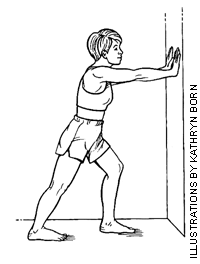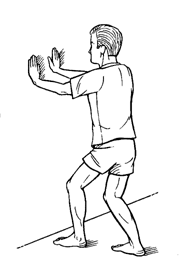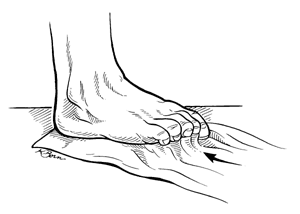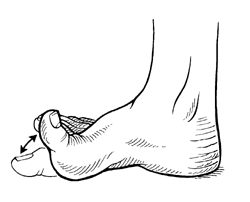
Am Fam Physician. 2001;63(3):477-478
What is plantar fasciitis?
Plantar fasciitis (say: plant-er fash-ee-eye-tis) is a common cause of pain in the heel of your foot. Your heel may hurt, feel hot, swell or turn red. This is called inflammation. The inflammation occurs in the plantar fascia, which is a thin layer of tough tissue that supports the arch of the foot. The pain is usually worse when you first get out of bed.
What causes plantar fasciitis?
The cause is usually some combination of tightness of the foot and the calf, weakness of the foot, improper athletic training or stress on the arch of the foot. Also, too much use (running too far, too fast, too soon), shoes that don't fit, or certain play or work actions can hurt the plantar fascia.
How is plantar fasciitis treated?
Treatment can reduce or get rid of what is causing plantar fasciitis. Treatment can also lessen inflammation.
To decrease the stress on the plantar fascia, you may need to wear shoes with more arch support. You might even need to change the size of shoe you wear. Athletes and active people may need to spend less time doing actions that cause stress, like jogging, jumping or running. Sometimes, arch supports or special shoe inserts may be used.

Stretching and strengthening exercises are also good. Massaging your foot across the width of the plantar fascia before getting often helps lessen the from standing. Regular stretching (Pictures 1 and 2) will help your pain help prevent future episodes of pain.

Strengthening exercises may include towel curls, marble or coin pick ups and toe taps.
To do a towel curl, sit with your foot flat on the end of a towel placed on a smooth surface. Keeping your heel on the floor, pull the towel towad your body by curling up the towel with your toes (Picture 3).

To do marble pick ups, put a few marbles on the floor near a cup. Keeping your heel on the floor, pick up the marbles with your toes and drop them in the cup. For a greater challenge, you may try to pick up coins instead of marbles.
To do toe taps, you will lift all your toes off the floor and, while heel on the floor and four toes in the air, toe to the floor (Picture 4). Next you will change the order and tap the outside four toes to the floor a number of times while keeping the big toe in the air. Start with 10 taps and work up to 50 taps per session.

Inflammation can be treated in several ways. An ice massage, ice bath or an ice pack may help.
For ice massage, freeze water in a small paper cup, then rub the exposed end of the ice over the painful heel using a circular motion and medium pressure for 5 to 10 minutes.
For an ice bath, fill a shallow pan with water and ice and soak your heel for 10 to 15 minutes. Wear neoprene toe covers (special covers you can buy at a medical supply store) or keep your toes out of the ice water to keep the cold from hurting your toes.
Make an ice pack by putting crushed ice in a plastic bag wrapped in a towel and molding it to the foot. Another good way is to use a bag of frozen corn wrapped in a towel. Use the package of corn for 15 to 20 minutes. Icing your heel after exercising, stretching, strengthening and working can help prevent inflammation.
Other treatments include medicines that lessen the inflammation or cortisone shots into the heel. Talk to your doctor about side effects and risks of these treatments.